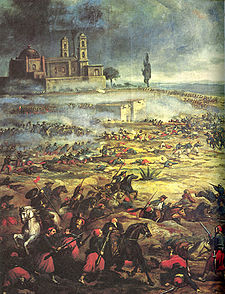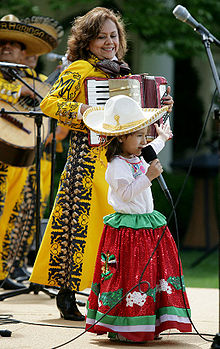Cinco de Mayo
From Wikipedia, the free encyclopedia
| Cinco de Mayo |
Battle of Puebla |
| Observed by |
|
| Type |
multinational |
| Date |
May 5, 1862 |
| Observances |
- Regional celebration in Mexico of battle victory.
- Celebration in the United States of Mexican-American culture and experiences. Only somewhat celebrated in Mexico.
- Food, music, folkloric dancing
|
Cinco de Mayo (
Spanish for "fifth of May") is a holiday celebrated in the
United States and primarily limited to the state of
Puebla in Mexico.
[1][2] The holiday commemorates the Mexican army's unlikely victory over
French forces at the
Battle of Puebla on May 5, 1862, under the leadership of Mexican General
Ignacio Zaragoza Seguín.
[3][4]
Cinco de Mayo is not "an obligatory federal holiday" in Mexico, but rather a holiday that can be observed voluntarily.
[5][6] While Cinco de Mayo has limited significance nationwide in Mexico, the date is observed in the
United States (also voluntarily) and other locations around the world as a celebration of Mexican heritage and pride.
[7] Cinco de Mayo is not
Mexico's Independence Day,
[8] which actually is September 16,
[9] the most important national patriotic holiday in Mexico.
[10]
History
In 1861,
Benito Juarez stopped making interest payments to countries that Mexico owed money to. In response, France
[11] attacked Mexico to force payment of this debt. France decided that it would try to take over and occupy Mexico.
[12] France was successful at first in its invasion; however, on May 5, 1862, at the city of
Puebla,
Mexican forces were able to defeat an attack by the larger French army.
In the Battle of Puebla, the Mexicans were led by General Ignacio
Zaragoza Seguín. Although the Mexican army was victorious over the
French at Puebla, the victory only delayed the French advance on
Mexico City. A year later, the French occupied Mexico. The French occupying forces placed
Maximilian I, Emperor of Mexico
on the throne of Mexico in 1864. The French, under pressure from the
United States, eventually withdrew in 1866-1867. Maximilian was deposed
by President
Benito Juarez and executed, five years after the Battle of Puebla.
The Battle of Puebla was important for at least two reasons. First,
although considerably outnumbered, the Mexicans defeated a much
better-equipped French army. "This battle was significant in that the
4,000 Mexican soldiers were greatly outnumbered by the well-equipped
French army of 8,000 that had not been defeated for almost 50 years."
[13][14]
Second, it was significant because since the Battle of Puebla no
country in the Americas has been invaded by an army from another
continent.
[15]
History of observance
According to a paper published by the
UCLA Center for the Study of Latino Health and Culture about the origin of the observance of Cinco de Mayo in the
United States, the modern American focus on the people of the world that day first started in
California in the
1860s in response to the resistance to French rule in Mexico.
[16]
The 2007 paper notes that "The holiday, which has been celebrated in
California continuously since 1863, is virtually ignored in Mexico."
[16]
Observances
Mexico
Cinco de Mayo is a regional holiday limited primarily to the state of
Puebla. There is some limited recognition of the holiday in other parts of the country.
[17] For the most part the celebrations combine food, music, and dancing.
United States
In the United States Cinco de Mayo has taken on a significance beyond that in Mexico.
[16][18][19][20] The date is perhaps best recognized in the United States as a date to celebrate the culture and experiences of
Americans of Mexican ancestry, much as
St. Patrick's Day,
Oktoberfest, and the
Chinese New Year are used to celebrate those of
Irish,
German, and
Chinese
ancestry respectively. Similar to those holidays, Cinco de Mayo is
observed by many Americans regardless of ethnic origin. Celebrations
tend to draw both from traditional Mexican symbols, such as the
Virgen de Guadalupe, and from prominent figures of Mexican descent in the United States, including
César Chávez.
[21] To celebrate, many display Cinco de Mayo banners while
school districts
hold special events to educate pupils about its historical
significance. Special events and celebrations highlight Mexican
culture, especially in its music and regional dancing. Examples include
baile folklórico and
mariachi demonstrations held annually at the Plaza del
Pueblo de Los Angeles, near
Olvera Street.
Commercial interests in the United States have capitalized on the
celebration, advertising Mexican products and services, with an
emphasis on beverages,
[22] foods, and music.
[23][24]
















